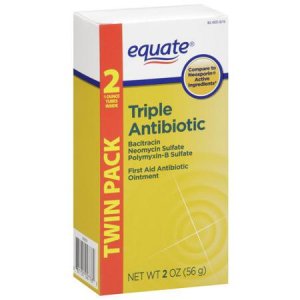that Fish Guy
Frag Swap Crusader!
I am in the Water a lot.
And because of this my Finger Tips Dry Out and Crack (Sometimes even Bleed).
So at Night (After I am done messing around in my Aquariums) I use this Neosporin knockoff by Equate.
Then I wrap my Fingers in Band-Aids for the Night to help keep them from Drying Out.
The First thing I do when I wake up (Before I do anything in any of my Aquariums) is I take the Band-Aids off and Take a Shower to Wash Off any Residue of this Product.
I have been doing this for Years and have never had any Problems.
But many would say that I am overly Paranoid.
If I started using this Product throughout the Day (Not just at Night when I am Sleeping) could it cause any Problems in my Reef Tanks?
Or is it Natural and Perfectly Safe?
Here is a Link to the Product.
http://www.walmart.com/ip/Equate-Triple-Antibiotic-First-Aid-Ointment-2-oz/20659621
I also have added a Picture of it Below.
The Ingredients are
Bacitracin
Neo-Mycin Sulfate
Polymyxin-B Sulfate.
Like I said it is a Cheap Knockoff of Neosporin First Aid Antibiotic.
Is it Safe to use?
My Fingers are Still Dry and I would like to use it More often than Once a Day.
Does anybody use this stuff? Or Regular Neosporin or anything Similar?
If so what have your experiences with it been when around Aquariums?
Any help or tips would greatly be appreciated.
And because of this my Finger Tips Dry Out and Crack (Sometimes even Bleed).
So at Night (After I am done messing around in my Aquariums) I use this Neosporin knockoff by Equate.
Then I wrap my Fingers in Band-Aids for the Night to help keep them from Drying Out.
The First thing I do when I wake up (Before I do anything in any of my Aquariums) is I take the Band-Aids off and Take a Shower to Wash Off any Residue of this Product.
I have been doing this for Years and have never had any Problems.
But many would say that I am overly Paranoid.
If I started using this Product throughout the Day (Not just at Night when I am Sleeping) could it cause any Problems in my Reef Tanks?
Or is it Natural and Perfectly Safe?
Here is a Link to the Product.
http://www.walmart.com/ip/Equate-Triple-Antibiotic-First-Aid-Ointment-2-oz/20659621
I also have added a Picture of it Below.
The Ingredients are
Bacitracin
Neo-Mycin Sulfate
Polymyxin-B Sulfate.
Like I said it is a Cheap Knockoff of Neosporin First Aid Antibiotic.
Is it Safe to use?
My Fingers are Still Dry and I would like to use it More often than Once a Day.
Does anybody use this stuff? Or Regular Neosporin or anything Similar?
If so what have your experiences with it been when around Aquariums?
Any help or tips would greatly be appreciated.

